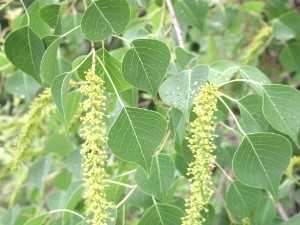
Triadica sebifera is a tree native to eastern Asia. It is commonly called Chinese tallow, Chinese tallowtree, Florida aspen, chicken tree, gray popcorn tree, or candleberry tree.
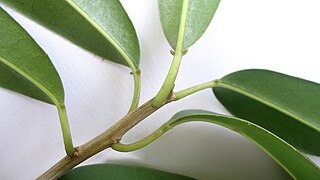
Sapium is a genus of flowering plants in the family Euphorbiaceae. It is widespread across most of Latin America and the West Indies. Many Old World species were formerly included in the genus, but recent authors have redistributed all the Old World species into other genera.

Omphalea is a plant genus of the family Euphorbiaceae first described as a genus in 1759. It is native to tropical parts of the Americas, the West Indies, Asia, Australia, and Africa.
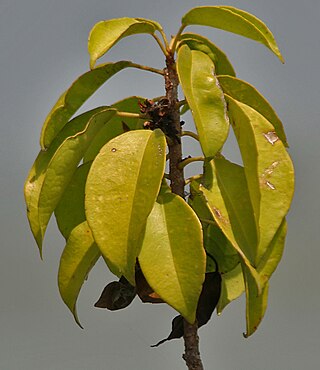
Excoecaria is a plant genus of the family Euphorbiaceae, formally described by Linnaeus in 1759. The genus is native to the Old World Tropics.
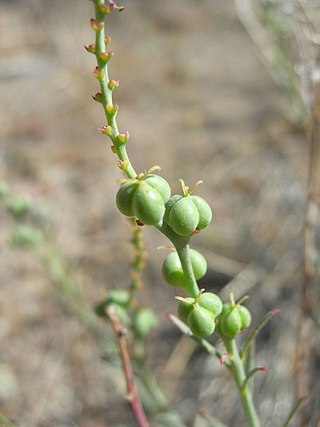
Stillingia is a plant genus of the family Euphorbiaceae, first described for modern science as a genus in 1767. The genus is native to Latin America, the southern United States, and various islands in the Pacific and Indian Oceans. Toothleaf is a common name for plants in this genus.

Charaxes bernardus, the tawny rajah, is a butterfly that belongs to the rajahs and nawabs group, that is, the Charaxinae group of the brush-footed butterflies family. This species can be found in India, China, Indomalaya, and onwards to Indonesia.

Sapium glandulosum is a species of tree in the family Euphorbiaceae. It is native to the Neotropics from Mexico and the Caribbean south to Argentina, and it has been cultivated elsewhere. It is the most common Sapium species. Its common names include gumtree, milktree, leche de olivo, and olivo macho.

Eupackardia is a monotypic moth genus in the family Saturniidae erected by Theodore Dru Alison Cockerell in 1912. Its only species, Eupackardia calleta, the calleta silkmoth, was described by John O. Westwood in 1853. It is found in Mexico, Guatemala, as well as in the states such as; Arizona, New Mexico, and Texas.

Sevenia boisduvali, the Boisduval's tree nymph, is a butterfly in the family Nymphalidae. There are four subspecies; all native to Africa.

Sclerocroton integerrimus, the duiker berry, is a tree in the family Euphorbiaceae, from Southern Africa.

Sevenia rosa, or Rosa's tree nymph, is a butterfly in the family Nymphalidae found in South Africa.

Sevenia morantii, the obscure tree nymph or Morant's tree nymph, is a butterfly in the family Nymphalidae found in southern Africa.
Caloptilia octopunctata is a species of moth of the family Gracillariidae. It is known from the Democratic Republic of Congo, Tanzania, Uganda, South Africa, India, Australia, New Zealand and Indonesia.
Caloptilia sapina is a moth of the family Gracillariidae. It is known from Namibia and South Africa.
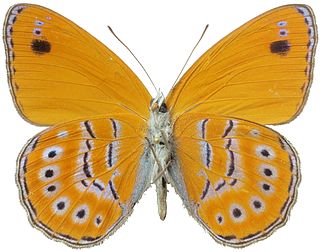
Sevenia amulia, the lilac tree nymph, is a butterfly in the family Nymphalidae. It is found in Nigeria, Cameroon, Gabon, the Republic of the Congo, the Democratic Republic of the Congo, Angola, Zambia and Botswana. The habitat consists of forests, especially near marshy areas.
Sevenia garega, the montane tree nymph, is a butterfly in the family Nymphalidae. It is found in eastern Nigeria, Cameroon, the Central African Republic, the Democratic Republic of the Congo, Uganda, Ethiopia, Kenya, north-western Tanzania, northern Zambia and Mozambique. The habitat consists of forests and woodland.

Sevenia occidentalium is a butterfly in the family Nymphalidae. It is found in Sierra Leone, Côte d'Ivoire, Ghana, Nigeria, Cameroon, Gabon, the Republic of the Congo, the Central African Republic, the Democratic Republic of the Congo, Ethiopia, Uganda, Rwanda, Kenya, Tanzania, Zambia and Angola. The habitat consists of forests.

Sevenia pechueli, the spotted lilac tree nymph, is a butterfly in the family Nymphalidae. The butterfly is found in Nigeria, Cameroon, the Republic of the Congo, Angola, the Democratic Republic of the Congo, the Central African Republic, Tanzania, Malawi, Zambia, and Namibia. The habitat consists of woodland, especially in marshy areas.
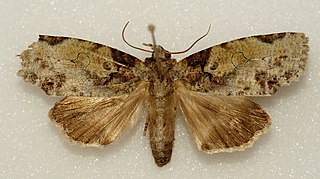
Gadirtha inexacta is a moth of the family Nolidae first described by Francis Walker in 1858. It is found in northern India and Myanmar, as well as on Borneo. It has also been recorded from Queensland and New South Wales in Australia.

Excoecaria simii, the forest pepper-seed or forest pepper-seed bush, is a species of flowering plant in the family Euphorbiaceae. It is endemic to South Africa, in forests of KwaZulu-Natal and Eastern Cape.















